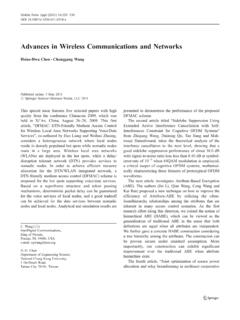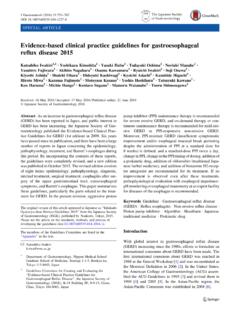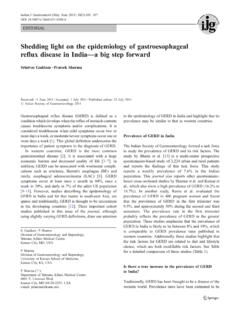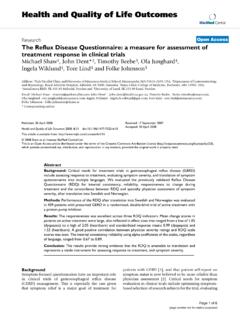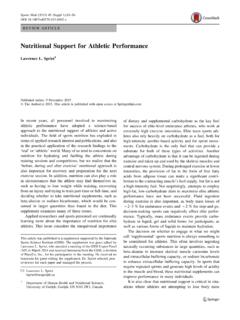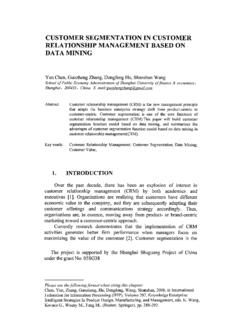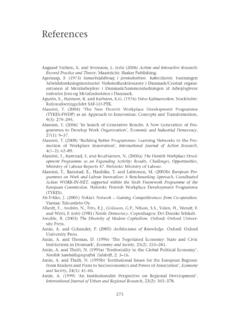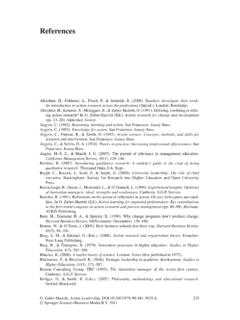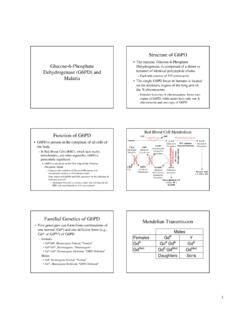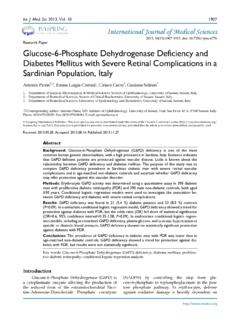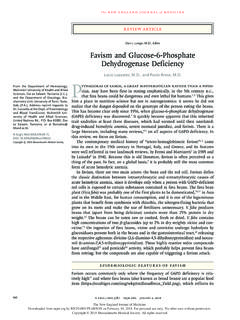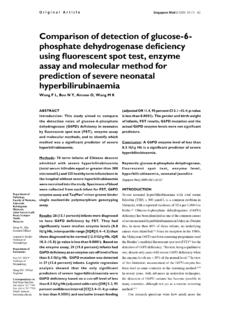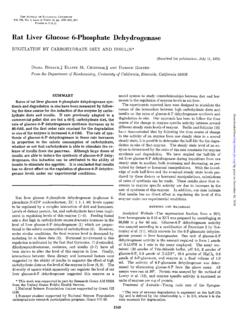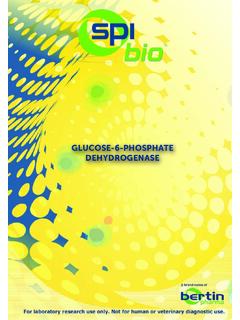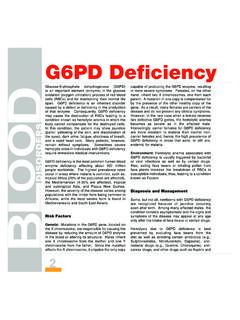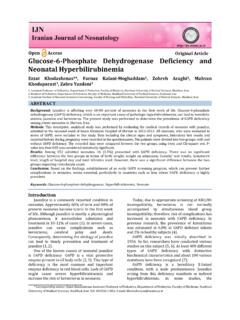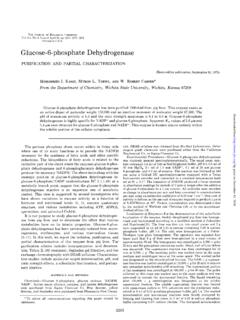Transcription of Glucose-6-phosphate dehydrogenase deficiency and malaria
1 & :AbstractGlucose-6- phosphate dehydrogenase (G6PD)is a cytoplasmic enzyme that is essential for a cell s ca-pacity to withstand oxidant stress. G6PD deficiency isthe commonest enzymopathy of humans, affecting over400 million persons worldwide. The geographical corre-lation of its distribution with the historical endemicity ofmalaria suggests that 66PD deficiency has risen in fre-quency through natural selection by malaria . This is sup-ported by data from in vitro studies that demonstrate im-paired growth of P. falciparumparasites in G6PD-defi-cient erythrocytes. Attempts to confirm that G6PD defi-ciency is protective in field studies of malaria have yield-ed conflicting results, but recent results from large casecontrol studies conducted in East and West Africa pro-vide strong evidence that the most common AfricanG6PD deficiency variant, G6PD A , is associated with asignificant reduction in the risk of severe malaria forboth G6PD female heterozygotes and male effect of female homozygotes on severe malaria re-mains unclear but can probably be assumed to be similarto that of comparably deficient male.
2 Key wordsGlucose-6- phosphate dehydrogenasedeficiency Severe malaria Protection Heterozygotes HemizygotesAbbreviationsG6 PDGlucose-6-phosphatedehydrogenase&bdy:G 6 PDGlucose-6- phosphate dehydrogenase G6PD is a cytoplas-mic, so-called house-keeping enzyme that catalyses thefirst and rate-limiting step of the hexose monophosphatepathway for pentose phosphate synthesis. This pathway isan important source of NADPH that is required for sever-al biosynthetic reactions and is essential for maintainingadequate intracellular levels of reduced forms of glutathi-one and other sulphydryl groups. By preserving and re-generating reduced forms of glutathione as well as pro-moting the stability of catalase, NADPH plays a majorrole in a cell s ability to withstand oxidant stress.
3 Thehexose monophosphate shunt catalysed by G6PD is alsoan important source of ribose which is essential for pro-duction of nucleotide coenzymes, the replication of nu-cleic acids and, therefore, cell division [1]. The biologicalimportance of G6PD is underlined by the fact that this en-zyme has been detected in virtually every cell type in allcontemporary organisms [2].Along with the loci encoding colour blindness and fac-tor VIII, the G6PD gene is located in the telomeric regionon the long arm (Xq28) of the X chromosome [3, 4]. TheG6PD gene consists of 13 exons and spans approximately18 kb [5]. The G6PD protein has a molecular weight of59 kDa, and the active enzyme is composed variably oftwo or four identical 515 amino acid subunits [6].
4 Genetic polymorphism of G6 PDThe G6PD locus is probably the most polymorphic locusin humans, with over 300 allelic variants known, at leastC. Ruwende ())Department of Medicine, Johns Hopkins Medical Institutions,1830 East Monument Street, Baltimore, MD 21205, USAA. HillWellcome Trust Centre for Human Genetics,University of Oxford, Windmill Road, Oxford OX 3 7BN, UKJ Mol Med (1998) 76:581 588 Springer-Verlag 1998 REVIEW&roles:Cyril Ruwende Adrian HillGlucose-6- phosphate dehydrogenase deficiency and malaria &misc:Received: 14 October 1996 / Accepted: 13 October 1997 CYRILRUWENDE earned his doctorate fromOxford University, UK. He isnow a Resident in Medicine atJohns Hopkins University, andconcentrates on geneticsusceptibility to earned his medical degreefrom Oxford University.
5 Hisinterests relate to geneticsusceptibility to infectiousdiseases and :87 of which have reached polymorphic ( >1%) fre-quencies [7, 8]. These variants have been characterisedbiochemically based primarily on their differing residualenzyme activities, electrophoretic mobility patterns andalso on their physicochemical (thermostability, chro-matographic behaviour) and kinetic (Kmfor glucose -6phosphate or NADPH, pH dependence and utilisation ofsubstrate analogues) properties [7].The G6PD variants are grouped into the followingclasses depending on the degree of enzyme deficiencyand associated clinical symptoms: Class I: severely deficient associated with chronic non-spherocytic anaemia Class II: severely deficient, <10% residual enzyme ac-tivity Class III: moderately deficient, 10 60% enzyme activity Class IV: near normal or normal enzyme activity,60 150% enzyme activity Class V: enzyme activity, >150%To date, comparison of gene sequences encoding enzymevariants to that of the normal G6PD B gene has led to theidentification of at least 34 different mutations [7].
6 Thesemutations are widely spread throughout the gene, beingfound in all exons except exon 3 and exon 13. All butone of these are point mutations associated with aminoacid substitutions [2]. The exception is G6PD Sunder-land, which is due to a 3-bp deletion and results in theloss of an isoleucine residue [9]. Interestingly, a substan-tial number of these variants are associated with variableforms of G6PD enzyme deficiency . The absence in theG6PD gene of larger deletions, or other mutations suchas nonsense mutations or frameshift mutations thatwould completely abolish the function of the protein,suggests that complete absence of the G6PD enzyme isincompatible with life [2].
7 In Africa G6PD is essentially a tri-allelic polymor-phism (Table 1). G6PD B, the normal variant associatedwith normal or 100% enzyme activity, is the commonestallele, with frequencies of 60 80%. G6PD A which has90% of the activity of G6PD B is the next commonest al-lele with frequency between 15 40%. The third allelewhich is the common deficiency allele in Africa is G6 PDA . It is a class III variant with 12% enzyme activity, andit varies in frequency from 0% to 25% [7].G6PD A is unique in that it contains two first at nucleotide 376, which on its own gives rise toG6PD A [10], is an adenine to guanine substitution thatresults in an asparagine to aspartate amino acid substitu-tion while the second mutation, usually a guanine to ade-nine substitution at nucleotide 202, leads to a valine tomethionine substitution [11].
8 Although the nucleotide202 substitution accounts for at least 95% of the G6 PDA molecular variants in Africa, in a minority of individ-uals two other alternative second mutation sites havebeen identified at nucleotides 680 and 968 [11, 12].G6PD deficiencyFrequency and distributionG6PD deficiency is the commonest enzymopathy in manaffecting over 400 million persons worldwide [13]. Thisdisorder, which is caused by a multitude of the differentstructural allelic mutants of the G6PD gene referred toabove, is found mainly in the tropical and sub-tropicalregions of the world, with the highest rates, usually5 30%, being found in Africa, Asia, the Middle East, theMediterranean and Papua New Guinea [7].
9 Worldwidethe frequency figures range from 62% in Kurdish Jews in Japan and northern Europe [14].Clinical featuresClinical expression of G6PD deficiency is probably de-pendent on an interaction of the molecular properties ofa given deficiency variant, exogenous factors and, possi-bly, additional genetic factors [7]. In unstressed normalcells G6PD activity is only 2% of total capacity [14], andtherefore it is hardly surprising that most individualswith the more common class II and III G6PD deficiencyvariants are usually asymptomatic. Although there is nodirect evidence to support this, it is likely that there is acorrelation between the degree of enzyme deficiency andthe propensity to develop clinical most striking clinical syndrome associated withG6PD deficiency , acute haemolytic anaemia, occurs as amanifestation of this disorder on the mature red bloodcell.
10 On account of its long non-nucleated life-span andhence its impaired ability to generate adequate levels ofNADPH and reduced forms of glutathione, the matureerythrocyte has a diminished reductive capacity to re-spond to oxidant stress. Uncompensated oxidant stress inthe erythrocyte leads to oxidation of haemoglobin tomethaemoglobin, heinz body formation and membranedamage [15]. In the extreme this leads to haemolysiswhile less severe oxident stress increases the deformabil-ity of the erythrocyte and probably enhances the likeli-hood that the stressed cell will be removed from circula-tion by the reticuloendothelial system [16, 17].Acute haemolytic anaemia is therefore the most fre-quent clinical manifestation of G6PD deficiency .
